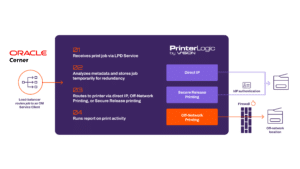In today’s fast-paced digital era, businesses are searching for ways to secure their data and documents without disrupting printing processes. One feature that has gained mainstream prominence is pull printing. Also known as follow-me printing or secure printing, pull printing transforms traditional printing workflows by introducing a user-friendly approach to authentication and keeping confidential documents in the right hands.
In this blog post, we will delve into the concept of pull printing and uncover three ways pull printing supports businesses in 2023.
What is pull printing?
At its core, pull printing is a print management strategy that allows users to securely release and retrieve their print jobs from any network-connected printer within an organization. Unlike the traditional “push” method, where print jobs are sent directly to a specific printer, pull printing employs a virtual queue system. Users send their documents to the virtual queue and can then authenticate themselves at any pull printing-enabled printer to release and print their files.
Pull printing has become so widely adopted that its capabilities have extended to remote employees that need to print off-network. Click here to learn more about pull printing for off-network and remote employees.
How does pull printing streamline printing processes?
One of the key advantages of pull printing is its ability to streamline printing workflows, optimizing efficiency and productivity—while adding an extra layer of security. With the traditional approach, employees often face long queues at specific printers, leading to delays and frustration. To top it all off, users can retrieve all of their queued print jobs at the printer in bulk, instead of making a trip to the printer for every print job.
Pull printing offers a device-agnostic approach to printing as well. Users can send print jobs from their computers, laptops, or mobile devices to a virtual queue (instead of spooling on a print server), allowing them to print on demand at their convenience. This flexibility saves time and improves productivity, as employees can retrieve their documents from any nearby printer without having to wait in line or walk to a specific location.
Moreover, if a printer is out of order or busy, users can easily redirect their print jobs to an available device or simply walk to another pull printing-enabled printer to release their print jobs, further enhancing efficiency.
How does pull printing optimize security?
In addition to streamlining workflows, pull printing significantly enhances document security. In traditional print environments, sensitive documents may be left unattended in shared output trays, increasing the risk of accidental (or intentional) document theft. Even if documents aren’t stolen, the last thing you want is for employees to see sensitive information like how much money Tom in sales is raking in or a list of expected layoffs following a merger.
Pull printing addresses this concern by requiring user authentication at the printer before releasing the print job, ensuring that only authorized individuals can access and retrieve the printed materials, mitigating the risk of data and confidentiality breaches.
Industries dealing with sensitive information, such as healthcare, finance, and legal services, greatly benefit from pull printing’s heightened security measures. Confidential patient records, financial statements, legal documents, and other sensitive materials remain protected until the intended recipient is physically present at the printer and authenticates their identity.
How does pull printing address sustainability initiatives?
Pull printing offers instant financial and environmental benefits to organizations by minimizing print waste and associated costs. Instead of automatically printing every document, print jobs remain in the virtual queue until the user releases them at the printer. This allows users to review their documents, make corrections, or delete unnecessary pages before printing.
The reduction in print waste not only saves money on paper and ink but also contributes to a more sustainable environment. According to Deloitte’s 2023 Sustainability Report, 54% of organizations use climate-friendly solutions to achieve their sustainability goals.
And this push for sustainability isn’t only to preserve the environment, either. It’s to lure in eco-conscious consumers.
Research shows that consumers have become more selective in the brands they choose. A separate Deloitte study shows that consumers prefer companies actively reducing their carbon footprint and committing to ethical working practices—both of which pull printing can help cover.
So, is pull printing a must-have feature?
If your organization is adopting additional security measures and viewing sustainability as a key player in your future business success—then, yes. Even if you’re only looking to cut print costs, implementing pull printing pays quick dividends.
As businesses strive for increased efficiency, productivity, and security, pull printing emerges as a valuable tool. Its user-centric approach and enhanced document security make it an ideal choice for organizations of all sizes and industries. By implementing pull printing, businesses can optimize their printing processes, cut costs, and strengthen their overall security posture, setting the stage for success in 2023 and beyond.
At PrinterLogic, we offer a free 30-day trial so you can see if pull printing is a good fit for your current environment. Schedule a demo today.


